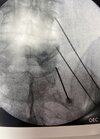- Joined
- Mar 16, 2016
- Messages
- 77
- Reaction score
- 11
Going to start using Venom needles for RFA. Office bought 20G 100mm length, 10mm active tip probes for all RFAs.
Those of you using Venom needles, do you use different active tips for cervical vs lumbar/SI/genicular? If so do you mind posting what are you using?
Worried the 10mm active tip in the cervical region will cause too large of a burn and risk of getting closer to vital structures being burned. Thoughts?
Those of you using Venom needles, do you use different active tips for cervical vs lumbar/SI/genicular? If so do you mind posting what are you using?
Worried the 10mm active tip in the cervical region will cause too large of a burn and risk of getting closer to vital structures being burned. Thoughts?

